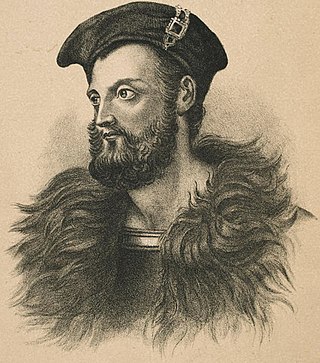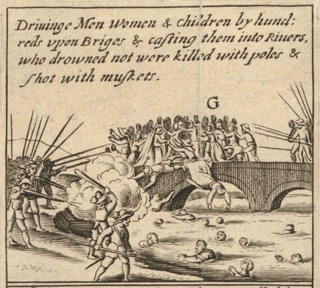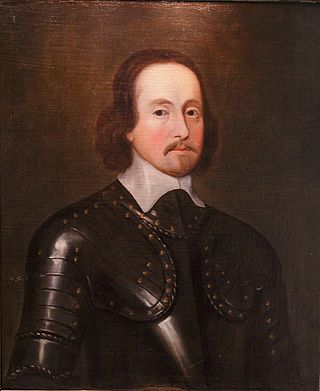This article needs additional citations for verification .(February 2015) |
| |||||
| Centuries: | |||||
|---|---|---|---|---|---|
| Decades: | |||||
| See also: | Other events of 1653 List of years in Ireland | ||||
Events from the year 1653 in Ireland.
This article needs additional citations for verification .(February 2015) |
| |||||
| Centuries: | |||||
|---|---|---|---|---|---|
| Decades: | |||||
| See also: | Other events of 1653 List of years in Ireland | ||||
Events from the year 1653 in Ireland.

Oliver Cromwell was an English statesman, politician and soldier, widely regarded as one of the most important figures in the history of the British Isles. He came to prominence during the 1639 to 1653 Wars of the Three Kingdoms, initially as a senior commander in the Parliamentarian army and latterly as a politician. A leading advocate of the execution of Charles I in January 1649, which led to the establishment of The Protectorate, he ruled as Lord Protector from December 1653 until his death in September 1658. Cromwell remains a controversial figure due to his use of the army to acquire political power, and the brutality of his 1649 campaign in Ireland.

Lieutenant-General James FitzThomas Butler, 1st Duke of Ormond, KG, PC, was an Anglo-Irish statesman and soldier, known as Earl of Ormond from 1634 to 1642 and Marquess of Ormond from 1642 to 1661. Following the failure of the senior line of the Butler family, he was the second representative of the Kilcash branch to inherit the earldom.

Owen Roe O'Neill was a Gaelic Irish soldier and one of the most famous of the O'Neill dynasty of Ulster. O'Neill left Ireland at a young age and spent most of his life as a mercenary in the Spanish Army serving against the Dutch in Flanders during the Eighty Years' War. After the Irish Rebellion of 1641, O'Neill returned and took command of the Irish Confederate Ulster Army. He is known for his victory at the Battle of Benburb in 1646.

Sir Hardress Waller, was an English Protestant who settled in Ireland and fought for Parliament in the Wars of the Three Kingdoms. A leading member of the radical element within the New Model Army, he signed the death warrant for the Execution of Charles I in 1649; after the Stuart Restoration in 1660, he was condemned to death as a regicide, a sentence commuted to life imprisonment.

The Irish Confederate Wars, also called the Eleven Years' War, took place in Ireland between 1641 and 1653. It was the Irish theatre of the Wars of the Three Kingdoms, a series of civil wars in the kingdoms of Ireland, England and Scotland – all ruled by Charles I. The conflict had political, religious and ethnic aspects and was fought over governance, land ownership, religious freedom and religious discrimination. The main issues were whether Irish Catholics or British Protestants held most political power and owned most of the land, and whether Ireland would be a self-governing kingdom under Charles I or subordinate to the parliament in England. It was the most destructive conflict in Irish history and caused 200,000–600,000 deaths from fighting as well as war-related famine and disease.

The Wars of the Three Kingdoms, sometimes known as the British Civil Wars, were a series of intertwined conflicts fought between 1639 and 1653 in the kingdoms of England, Scotland and Ireland, then separate entities united in a personal union under Charles I. They include the 1639 to 1640 Bishops' Wars, the First and Second English Civil Wars, the Irish Confederate Wars, the Cromwellian conquest of Ireland and the Anglo-Scottish war (1650–1652). They resulted in victory for the Parliamentarian army, the execution of Charles I, the abolition of monarchy, and founding of the Commonwealth of England, a unitary state which controlled the British Isles until the Stuart Restoration in 1660.

Sir Phelim Roe O'Neill of Kinard was an Irish politician and soldier who started the Irish rebellion in Ulster on 23 October 1641. He joined the Irish Catholic Confederation in 1642 and fought in the Wars of the Three Kingdoms under his cousin, Owen Roe O'Neill, in the Confederate Ulster Army. After the Cromwellian conquest of Ireland O’Neill went into hiding but was captured, tried and executed in 1653.

The Irish Rebellion of 1641 was a Catholic-led uprising in Ireland, whose demands included an end to anti-Catholic discrimination, greater Irish self-governance, and return of confiscated Catholic lands. Its timing was partially driven by the dispute between Charles I and his opponents—the English Parliamentarians and Scottish Covenanters—which the rebels feared would lead to an invasion and further anti-Catholic measures. Beginning as an attempted coup d'état by Catholic gentry and military officers, it developed into a widespread rebellion and ethnic conflict with English and Scottish Protestant settlers. It led to the 1641–1652 Irish Confederate Wars, part of the Wars of the Three Kingdoms, with up to 20% of the Irish population becoming casualties.

Confederate Ireland, also referred to as the Irish Catholic Confederation, was a period of Irish Catholic self-government between 1642 and 1652, during the Eleven Years' War. Formed by Catholic aristocrats, landed gentry, clergy and military leaders after the Irish Rebellion of 1641, the Confederates controlled up to two-thirds of Ireland from their base in Kilkenny; hence it is sometimes called the "Confederation of Kilkenny".

The Cromwellian conquest of Ireland or Cromwellian war in Ireland (1649–1653) was the re-conquest of Ireland by the forces of the English Parliament, led by Oliver Cromwell, during the Wars of the Three Kingdoms. Cromwell invaded Ireland with the New Model Army on behalf of England's Rump Parliament in August 1649.

Lieutenant-General Michael Jones, c. 1606 to 10 December 1649, was an Irish-born soldier of Welsh descent who fought for Parliament and the Commonwealth in the War of the Three Kingdoms, primarily in Ireland. Third son of Lewis Jones, Bishop of Killaloe, his brothers Henry and Ambrose were also bishops in the Protestant Church of Ireland.

Ireland during the period of 1536–1691 saw the first full conquest of the island by England and its colonization with mostly Protestant settlers from Great Britain. This would eventually establish two central themes in future Irish history: subordination of the country to London-based governments and sectarian animosity between Catholics and Protestants. The period saw Irish society outside of the Pale transform from a locally driven, intertribal, clan-based Gaelic structure to a centralised, monarchical, state-governed society, similar to those found elsewhere in Europe. The period is bounded by the dates 1536, when King Henry VIII deposed the FitzGerald dynasty as Lords Deputies of Ireland, and 1691, when the Catholic Jacobites surrendered at Limerick, thus confirming Protestant dominance in Ireland. This is sometimes called the early modern period.

Events from the year 1650 in Ireland.
Events from the year 1654 in Ireland.

The Portadown massacre took place in November 1641 at Portadown, County Armagh, during the Irish Rebellion of 1641. Irish Catholic rebels, likely under the command of Toole McCann, killed about 100 British Protestant settlers by forcing them off the bridge into the River Bann, and shooting those who tried to swim to safety. The settlers were being marched east from a prison camp at Loughgall. This was the biggest massacre of Protestants during the rebellion, and one of the bloodiest during the Irish Confederate Wars. The Portadown massacre, and others like it, terrified Protestants in Ireland and Great Britain, and were used to justify the Cromwellian conquest of Ireland and later to lobby against Catholic rights.

Charles Coote, 1st Earl of Mountrath was an Anglo-Irish peer, the son of Sir Charles Coote, 1st Baronet, and Dorothea Cuffe, the former being an English veteran of the Battle of Kinsale (1601) who subsequently settled in Ireland.
Presented below is a chronology of the major events of the Irish Confederate Wars from 1641 to 1653. This conflict is also known as the Eleven Years War. The conflict began with the Irish Rebellion of 1641 and ended with the Cromwellian conquest of Ireland (1649–53).
Colonel Philip O'Reilly was a member of parliament for County Cavan, Ireland in the Irish Parliament from 1639 to 1641, and a leading member of the 1641 Rebellion.

Sir Theophilus Jones, was an Irish soldier and government official of Welsh descent. One of five sons born to Lewis Jones, Bishop of Killaloe in the Church of Ireland, he formed part of a close-knit and powerful Protestant family.